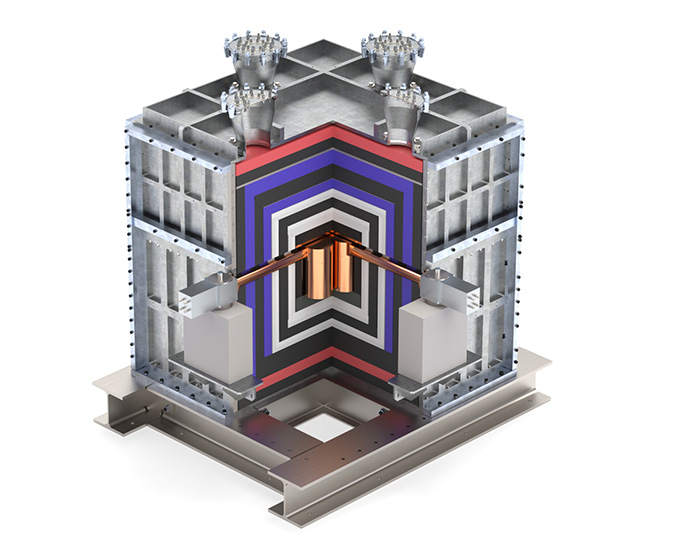A small neutrino detector has found its base in a fresh environment – in a nuclear reactor.
Conventional subatomic particle detectors require metric tone of material. But the new detector has a mass less than 3 pounds. Think Chihuahua. And he successfully discovered Antineutrinos, Neutrino antimatter counterparts, transmitting from a nuclear power plant in Leibstadt, Switzerland, reporters report in a January 9 work in Arxiv.org.
“This is actually great,” says neutrino physicist Kate Scholberg from the university, which was not involved in the research. “People have tried to do this for many decades and now they have finally succeeded.”
Similar reduced neutrinos detectors have descended neutrinos and antineutrinos created by laboratory sources of particles. Nuclear reactors extract relatively low antineutrinos with low energy. By measuring those low -energy particles, such detectors can help test the theories of physics or detect the internal work of atomic nuclei. Some scientists have proposed that compact equipment can be used to monitor nuclear reactors for activity that signals the development of nuclear weapons.
Neutrinos are very difficult to see. For the most part, they interact with matter so rarely that detectors must be too high to offer more opportunities for neutrinos to interact inside.
But one type of interaction is more common, in which a neutrino or antineutrino releases an atomic nucleus than a proton or neutron. Neutrin-nuclear interactions detectors can be built quite small-with a catch. They must be extremely sensitive. Observing the nucleus reprint is like feeling the movement of a Bowling ball hit by a ping-pong ball. The effect was first observed in 2017, using a laboratory source of particles.
In the new study, a detector made by the Germanium crystal kidnapped about 400 antineutrinos from Reactor Leibstadt over 119 days. The number agrees with the forecasts from the established theory of particle physics, the standard model.

The neutrino detector (copper) is surrounded by lead (black) and polyethylene (red and white) layers to block other types of subatomic particles. Extra (blue) layers detect particles that can otherwise be confused with antineutrinos.
HeidelbergIn a neutrino-nuclear interaction, the complexity of the nucleus, with its constituent protons and neutrons, is washed. Truly is really like knocking on a Bowling Top. And the lower the energy of the particles that hit that core, the more as a bowling top is. With the reactor’s antineutrinos, “is just such a gentle collision that is very clean,” Scholberg says. “Any kind of strange fungal item that is happening in the nucleus doesn’t matter.”
Lack of fog makes measurements more sensitive to the new possible effects, such as undiscovered particles or sudden magnetism in neutrinos. “This opens a new channel in neutrino physics,” says physicist Christian Buck of the Max Planck Institute for Nuclear Physics in Heidelberg, a co -author of the study. “There may be new physics in that channel we don’t know now.” Other teams of scientists are already using data to control such effects, as reported in two letters presented in Arxiv.org on January 17 and January 21.
Scientists have previously found evidence of the nucleus from the neutrinos from the sun, using large detectors designed to see the dark matter, an invisible source of mass present in the cosmos.
This is not the alleged observation of the antineutrino of the reactor who dance the nuclei. Another team of scientists apparently saw the effect in 2022, but the result did not fully try with accepted theories, making it controversial. The new study excludes the possibility that the 2022 claim was correct, says Buck.
Neutrino detectors of this type may be useful for monitoring nuclear reactors for clandestine activity, some physicists have suggested. Antineutrinos distributed by nuclear reactors offer a signature of what is happening inside. Antineutrino energies, for example, can detect the amount of reactor plutonium, an important material for weapons production. But Antineutrino’s energies can be challenging to determine the use of the technique. The new experiment was also captured near the reactor, while some types of real -world monitoring will have to happen farther from the source.
And while the small detector size is a plus for practical applications, it had to be heavily worn in lead and other material to protect it from particles that can imitate Antinetrinos, making it less mobile.
“This is still a very way, very difficult to do physics,” says physicist Neutrino Jonathan Link I Virginia Tech in Blacksburg, who was not involved in the work. “But you always start with the first step of the baby.”
#small #neutrino #detector #scored #great #nuclear #reactor
Image Source : www.sciencenews.org